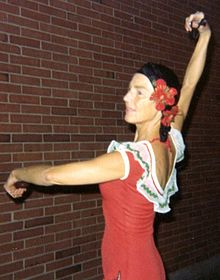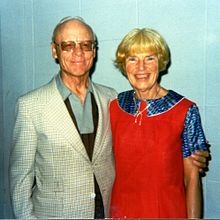Beulah invented aquatic art (synchronized swimming).
In her childhood, Beulah was mainly interested in music and ballet. At the age of 14, she started to take swimming lessons after being encouraged by her parents to learn how to swim and dive. However, the first experiences with swimming were very negative for her, because she continuously sank in the water. She started to read instructional books on swimming, decided to teach herself how to float and successfully continued this autodidactic learning in the following years. She attended several competitions and even won an Iowa AAU gold medal for the backstroke. In 1938, she finished her education at Coe College and started to work as a secretary for the Chamber of Commerce in Cedar Rapids. She began to find swimming laps boring, and to develop her idea of combining swimming with music and dance. After studying a book about rhythmic swimming, she created a routine of swimming strokes which were set to music. On the suggestion of her husband, coach, and manager Henry Gundling, Beulah took part at the duet competition in synchronized swimming at the Outdoor Nationals in Des Moines in 1948 together with Noreen Fenner and placed 10th. In the following years, Beulah increased her interest in performing solo routines, for which she designed her own costumes. She won several important competitions in North America, she took first place at the 1949 Canadian Synchronized Swimming Championships with a routine entitled The Swan after music by Camille Saint-Saëns. Moreover, she won the Outdoor solo title at the U.S. National AAU Synchronized Swimming Championships from 1950-1954. Gundling introduced solo synchronized swimming on an exhibition basis at the 1951 Pan American Games as well as the 1952 Helsinki Olympics, where she presented her program Thunderbird to music from the opera Natoma by Victor Herbert. After winning the gold medal of the solo event at the 1955 Pan American Games Beulah Gundling finished her sports career.
After winning the gold medal of the solo event at the 1955 Pan American Games Beulah Gundling finished her swimming career presenting compositions at many festivals held by the International Academy of Aquatic Art until she retired in 1991, having been awarded only First Class Honors of the IAAA for all of her works. In addition, she wrote nine books on swimming and gave numerous lectures all over the world.
In 1965 Beulah Gundling was the first synchronized swimmer to be inducted into the International Swimming Hall of Fame. In 2000 she had her final aquatic appearance in the documentary The Mermaid's Club: A History of Synchronized Swimming by Paul Carvalho. (source: Wikipedia)
Beulah invented aquatic art (synchronized swimming).
In her childhood, Beulah was mainly interested in music and ballet. At the age of 14, she started to take swimming lessons after being encouraged by her parents to learn how to swim and dive. However, the first experiences with swimming were very negative for her, because she continuously sank in the water. She started to read instructional books on swimming, decided to teach herself how to float and successfully continued this autodidactic learning in the following years. She attended several competitions and even won an Iowa AAU gold medal for the backstroke. In 1938, she finished her education at Coe College and started to work as a secretary for the Chamber of Commerce in Cedar Rapids. She began to find swimming laps boring, and to develop her idea of combining swimming with music and dance. After studying a book about rhythmic swimming, she created a routine of swimming strokes which were set to music. On the suggestion of her husband, coach, and manager Henry Gundling, Beulah took part at the duet competition in synchronized swimming at the Outdoor Nationals in Des Moines in 1948 together with Noreen Fenner and placed 10th. In the following years, Beulah increased her interest in performing solo routines, for which she designed her own costumes. She won several important competitions in North America, she took first place at the 1949 Canadian Synchronized Swimming Championships with a routine entitled The Swan after music by Camille Saint-Saëns. Moreover, she won the Outdoor solo title at the U.S. National AAU Synchronized Swimming Championships from 1950-1954. Gundling introduced solo synchronized swimming on an exhibition basis at the 1951 Pan American Games as well as the 1952 Helsinki Olympics, where she presented her program Thunderbird to music from the opera Natoma by Victor Herbert. After winning the gold medal of the solo event at the 1955 Pan American Games Beulah Gundling finished her sports career.
After winning the gold medal of the solo event at the 1955 Pan American Games Beulah Gundling finished her swimming career presenting compositions at many festivals held by the International Academy of Aquatic Art until she retired in 1991, having been awarded only First Class Honors of the IAAA for all of her works. In addition, she wrote nine books on swimming and gave numerous lectures all over the world.
In 1965 Beulah Gundling was the first synchronized swimmer to be inducted into the International Swimming Hall of Fame. In 2000 she had her final aquatic appearance in the documentary The Mermaid's Club: A History of Synchronized Swimming by Paul Carvalho. (source: Wikipedia)
Sponsored by Ancestry
Advertisement
Advertisement







